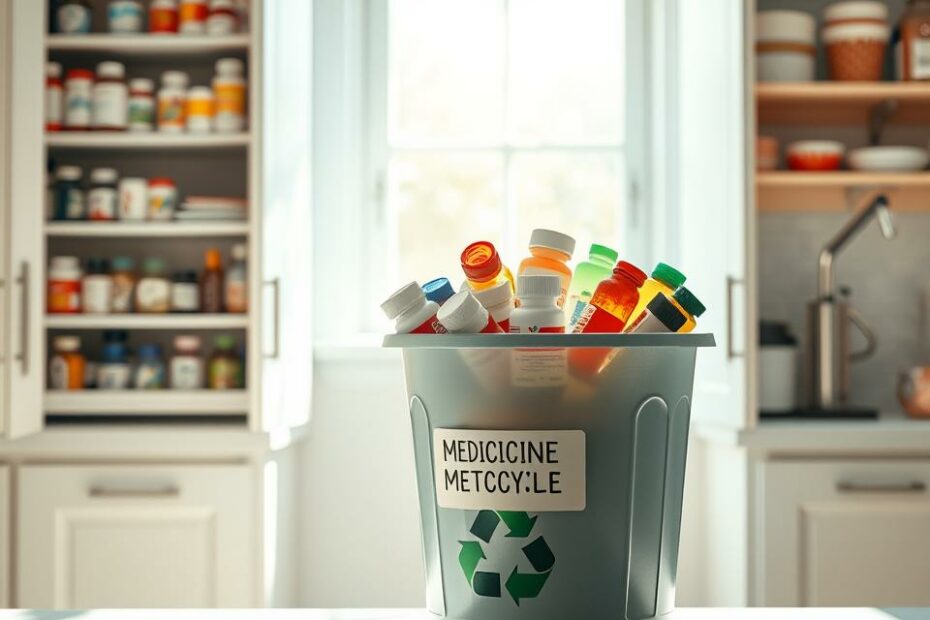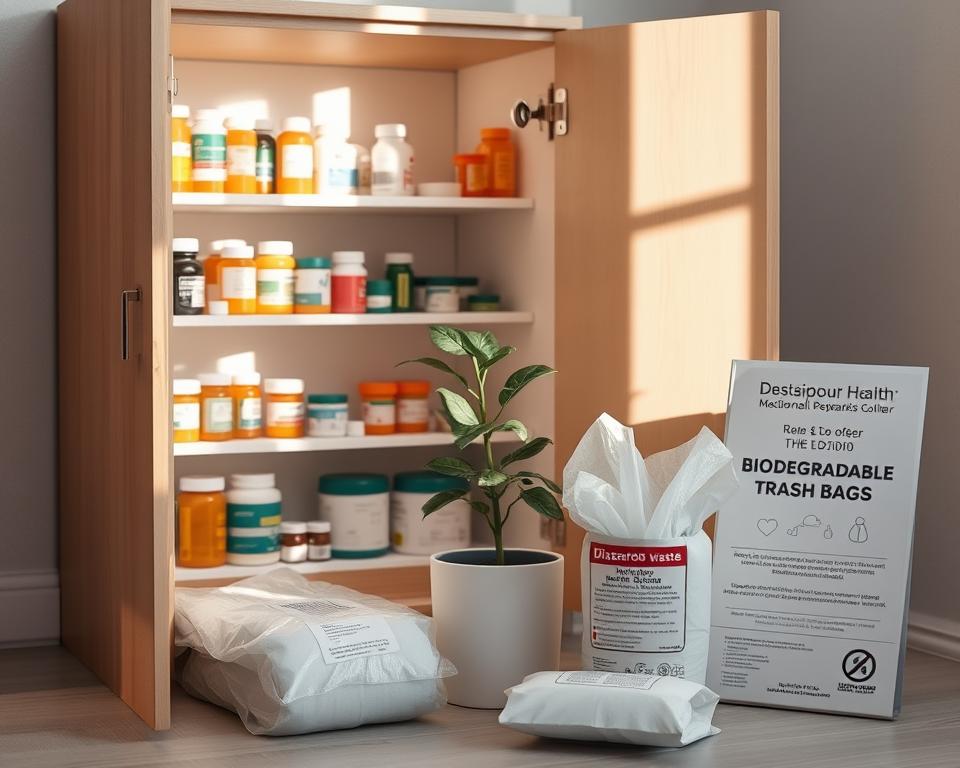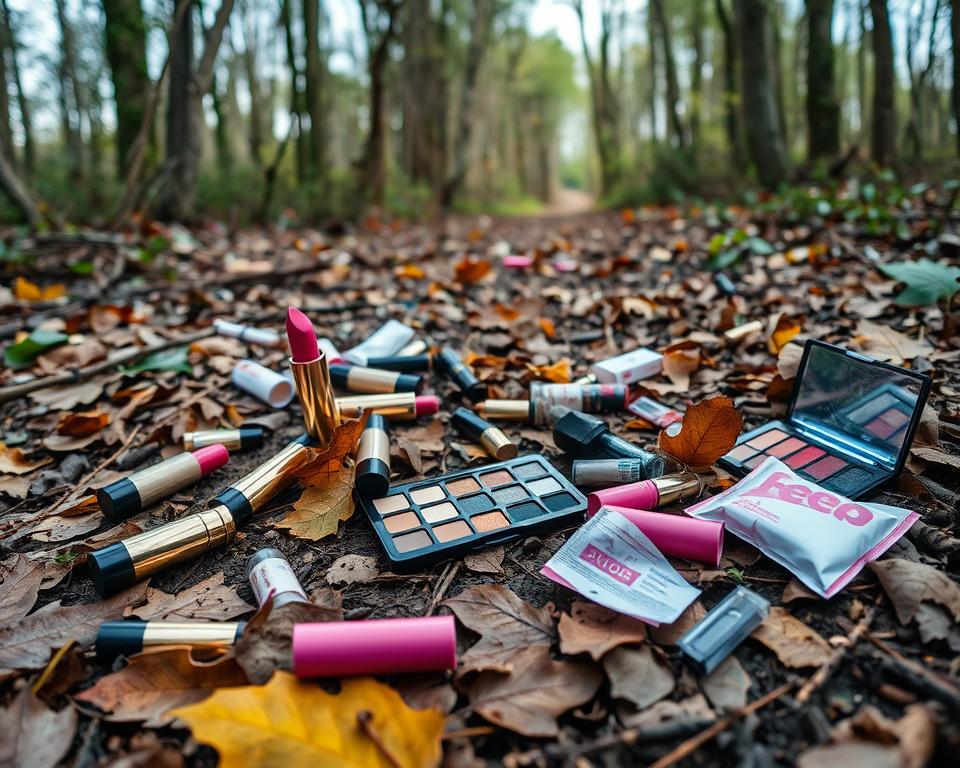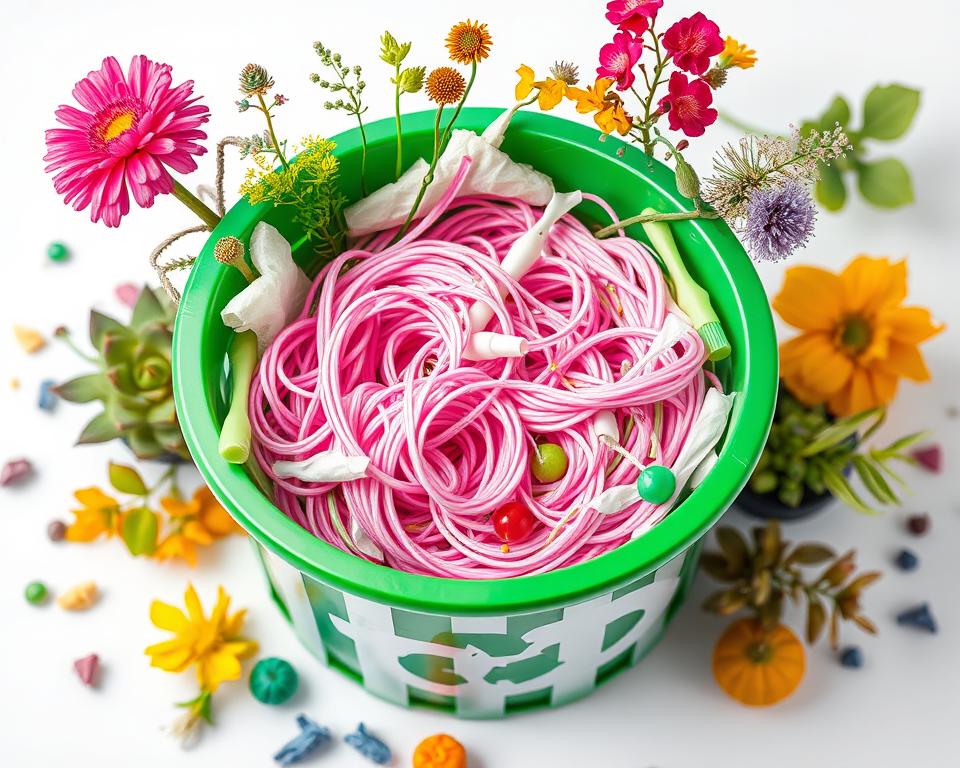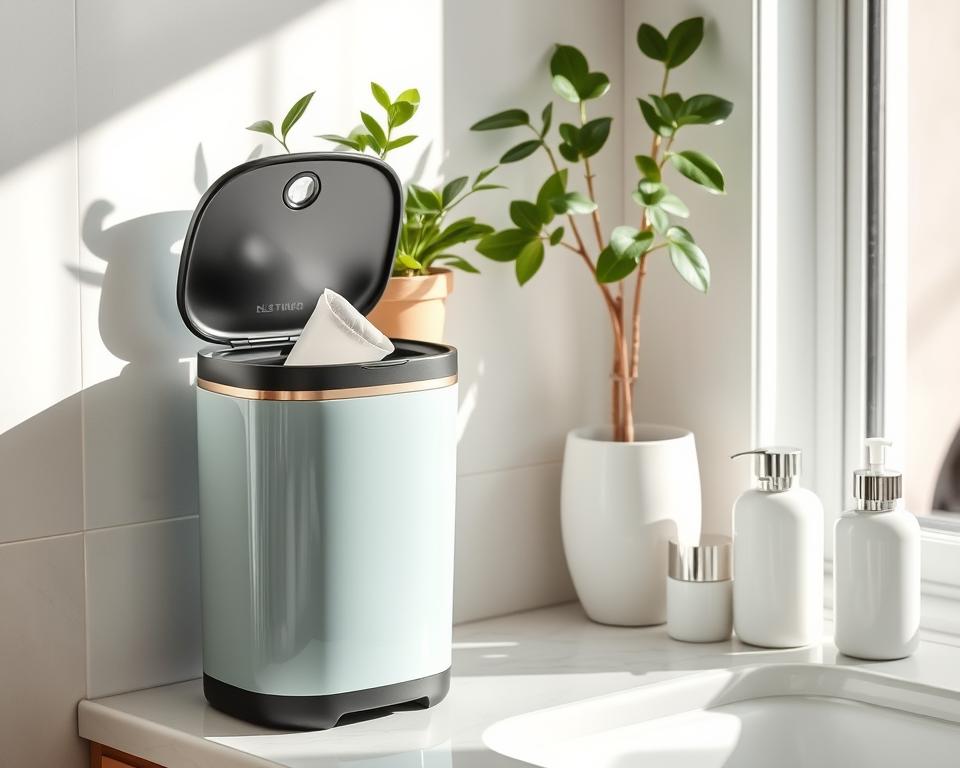Did you know over 2 million Americans accidentally take or misuse leftover medicines each year? Not getting rid of expired or unused medicines safely can be dangerous. It’s important to know how to dispose of them properly.
Your medicine is meant for you. But, it might be harmful to others. The best way to get rid of old medicines is through a drug take-back program. Or, you can follow safe steps at home. It’s key to handle medicines carefully to protect your family and the environment.
Key Takeaways
- Improper disposal of medicines can lead to accidental ingestion or misuse, putting your family at risk.
- Drug take-back programs are the preferred method for safely disposing of expired or unused medications.
- If a take-back program is not available, certain medications can be discarded in the household trash using specific steps.
- Flushing medications should only be done for a limited number of high-risk drugs on the FDA Flush List.
- Proper disposal of medications helps protect the environment and water supply from contamination.
Importance of Proper Medicine Disposal
Keeping expired or unused medicines at home can be risky. They might be taken by children or pets by mistake, causing harm. It’s important to dispose of them safely to protect your family and others.
Risks of Keeping Expired or Unused Medications
Expired or unused medicines can be found in many places in your home. They can be dangerous if taken by kids or pets. It’s crucial to dispose of them properly to avoid accidents.
Benefits of Safe Disposal for Your Family and Community
- Prevents accidental or intentional misuse of medicines, especially by children and pets
- Keeps medications out of the water supply, reducing environmental impact
- Supports the safe elimination of potent drugs, like opioids, to protect the community
Proper disposal of expired or unused medicines keeps your family safe. It also helps your community. Safe disposal prevents misuse and protects our environment.
| Disposal Method | Details |
|---|---|
| Drug Take-Back Programs | The U.S. Drug Enforcement Administration sponsors the National Prescription Drug Take Back Day, and many communities have their own drug take-back programs. These provide on-site drop-off boxes or mail-back options for safe medication disposal. |
| Household Trash Disposal | Almost all medicines, except those on the FDA’s Flush List, can be safely disposed of in the household trash. The FDA recommends mixing the medications with an unappealing substance like dirt, cat litter, or used coffee grounds before sealing in a plastic bag and throwing away. |
| Flushing Medications | The FDA maintains a list of medicines that can be flushed down the toilet when a take-back option is not readily available. This method is recommended for potentially dangerous drugs to prevent accidental ingestion or abuse. |
Knowing the risks of keeping expired medicines and the benefits of safe medication disposal helps you protect your family. It also makes your community a healthier, safer place.
Drug Take-Back Programs: The Preferred Option
Drug take-back programs are the best way to get rid of old or unused medicines. They are sponsored by the U.S. Drug Enforcement Administration (DEA) and many local communities. These programs offer safe and responsible ways to dispose of prescription and over-the-counter drugs.
National Prescription Drug Take-Back Day
The DEA organizes National Prescription Drug Take-Back Day events all over the country. During these events, people can give their expired or unused medicines to be disposed of safely. These events help keep dangerous drugs away from the wrong people and protect the environment.
Local Community Take-Back Programs
Many local communities also have their own drug take-back programs. These are found at pharmacies, police stations, or other public places. They provide a way to safely dispose of medicines all year round. Some even offer mail-back services or in-home disposal for more convenience.
Using these drug take-back programs ensures your medicines are disposed of responsibly. It keeps them out of the wrong hands. It’s the safest way to protect your family and community.
Dispose of old medicinesKlicken, um Alternative zu verwenden at Home: Step-by-Step Guide
If you can’t find a take-back program, you can safely dispose of old medicines at home. Just follow a few easy steps. This at-home medication disposal method keeps your family safe from expired or unused meds.
- Remove the drugs from their original containers.
- Mix the medications with something unappealing like used coffee grounds or cat litter. This makes them less likely to be misused.
- Put the mixture in a sealed container, like an empty can or bag. Then, throw it away in your trash.
- Scratch out any personal info on the empty packaging to keep your privacy safe.
Most medications can be safely thrown away in your trash when there’s no take-back program. But, some like opioids should be flushed down the toilet, as the FDA advises. Always check the FDA’s guide for the right way to dispose of old medicines at home.
By following these steps, you can protect your family and community. Safe disposal of old medicines at home is key to keeping everyone healthy and safe.
Flushing Medications: When It’s Recommended
For some medications, flushing them down the sink or toilet is the best way to get rid of them. This is especially true when you can’t find a take-back program. The U.S. Food and Drug Administration (FDA) has a list of drugs that should be flushed. These drugs can be dangerous if taken by someone else.
FDA Flush List for Potentially Harmful Drugs
Always check the label or patient information to see if your medication is on the FDA Flush List. This list includes opioid painkillers and transdermal fentanyl patches. These drugs can be very dangerous, even fatal, if taken by children or pets. Flushing them properly is the safest way to prevent misuse.
The FDA says to flush these medications when you can’t find a secure drug take-back program. This action helps prevent accidents or intentional misuse. It can lead to serious problems.
Disposing Medications in Household Trash
When it’s time to get rid of old, unused, or expired meds, throwing them away might be an option. But, make sure to prepare them right to avoid misuse or harm to the environment.
Preparing Medications for Disposal in the Trash
To safely throw away medications, follow these steps:
- Take the drugs out of their original containers. This makes it harder for others to know what they are.
- Blend the meds with something unappealing, like used coffee grounds or cat litter. This makes them less likely to be taken by mistake.
- Put the mix in a sealed bag or container before tossing it. This keeps the meds safe from being found or taken by accident.
Remember, only use the trash method for meds not on the FDA Flush List. These are drugs that should be flushed down the toilet because they’re dangerous.
By following these steps, you can safely dispose of medications. This helps keep your family and community safe from the dangers of bad disposal.
Handling Special Cases: Fentanyl Patches and Inhalers
Some medicines need special care when you throw them away. Fentanyl patches and inhalers are two examples that need extra attention.
Fentanyl patches are strong opioid pain relievers. Even after they’re used, they still have a lot of the drug left. It’s very important to flush these patches down the toilet. This keeps your family and community safe from the drug’s dangers.
Inhalers and other aerosol products should never be broken or set on fire. They can be very flammable and might even explode. Instead, call your local trash and recycling place for the right way to get rid of them.
By being careful with fentanyl patches and inhalers, you help keep your loved ones and the environment safe. It’s key to handle these special items right to keep our community healthy and safe.
| Product | Disposal Method |
|---|---|
| Fentanyl Patches | Flush down the toilet |
| Inhalers and Aerosols | Contact local trash and recycling facility for proper disposal instructions |
Addressing Environmental Concerns
There are worries about the environmental impact of medication disposal when we flush drugs down the drain. But, the U.S. Food and Drug Administration (FDA) says there’s little risk. They found that drug residues mainly come from our bodies, not from flushing.
The FDA and the U.S. Environmental Protection Agency (EPA) are very serious about these environmental concerns. They give clear advice on how to dispose of medications properly. They also keep an eye on how flushing medications affects our water and work to reduce any risks.
Impact of Flushing Medications on Water Supply
Flushing some medications, like opioids, is advised by the FDA to prevent misuse. But, there are worries about its long-term effects on our environment, especially our water. Thankfully, the FDA and EPA say there’s little risk to our water supply from flushing these drugs.
The best way to get rid of unused or expired medicines is to take them to a drug take-back location. These programs are easy and good for the environment. They help reduce the environmental impact of medication disposal.
Resources for Safe Medication Disposal
Getting rid of old or unused medications safely is key to protect your family and the planet. Luckily, there are many resources to help you dispose of expired or unwanted drugs properly.
The U.S. Drug Enforcement Administration (DEA) hosts National Prescription Drug Take Back Day events nationwide. These events offer a safe and easy way to get rid of your medications. You can find a collection site near you on the DEA’s website.
Many local areas also have their own drug take-back programs. These can be at police stations, pharmacies, or other spots. Just ask your city or county about what’s available in your area.
- Some pharmacies have drop-off boxes or mail-back services for safe disposal.
- The FDA has a Flush List of dangerous meds to flush down the toilet if take-back programs aren’t available.
- For meds not on the Flush List, mix them with something unappealing like dirt or cat litter before throwing them away.
Using these resources for safe medication disposal helps keep your family and the environment safe. Visit the DEA’s website or talk to your local authorities to find out more about your options.
Conclusion
Getting rid of old or unused medicines is key to keeping your family and the planet safe. The top choice is to use a drug take-back program if you can. But, you can also follow the FDA’s tips for safe disposal at home.
By being careful with your medicines, you stop them from being misused. This keeps them away from the wrong people and our water.
The main points are simple: use a drug take-back program if you can. If not, follow the FDA’s safe disposal tips at home. This protects your family and the community. Remember, disposing of medicines properly is a small but big step for a healthier, safer world.
This guide has shown you many ways to dispose of medicines safely. Take the time to get rid of your old or unwanted medicines. You’ll be making a big difference.
FAQ
What is the best way to dispose of expired, unwanted, or unused medicines?
The best way is through a drug take-back program or at-home disposal methods.
Why is it important to properly dispose of medications?
Improper disposal can harm your family and the environment. Expired or unused medicines can be dangerous, especially for children and pets. Proper disposal protects your family and community.
Where can I find drug take-back programs to safely dispose of old medicines?
The DEA sponsors National Prescription Drug Take-Back Day events nationwide. Many communities have local programs at pharmacies or police stations. These are the best options for disposing of medications.
How can I dispose of medications at home if a take-back program is not available?
If no take-back option is available, you can dispose of most medications in your trash. Remove the drugs from their containers and mix them with something unappealing like used coffee grounds or cat litter. Then, put the mixture in a sealed container before throwing it away.
What medications should be flushed down the sink or toilet?
For dangerous medications, flushing them down the sink or toilet is recommended when no take-back option is available. The FDA has a list of drugs that should be flushed due to serious risks if taken by someone they were not prescribed for.
How should I dispose of fentanyl patches and inhalers?
Fentanyl patches should be flushed, as they still contain a lot of the powerful opioid medicine even after use. Inhalers and aerosol products could be dangerous if punctured or thrown into a fire. Contact your local trash and recycling facility for proper disposal instructions.
What are the environmental concerns about flushing medications?
There are concerns about flushing medications’ impact on the water supply. However, the FDA has found negligible environmental risk from flushing drugs on their recommended flush list. Drug residues mainly enter water systems through people’s bodies, as many medications are not fully absorbed or metabolized.
Where can I find more information on safely disposing of unused or expired medications?
For more information, visit the FDA’s drug disposal webpage. You can find a DEA-authorized collector near you and get detailed instructions on at-home disposal methods and the FDA Flush List for dangerous drugs.
Source Links
- https://www.fda.gov/drugs/safe-disposal-medicines/disposal-unused-medicines-what-you-should-know
- https://www.springermedizin.de/assessment-of-practices-and-awareness-regarding-the-disposal-of-/26095530
- https://www.abstract13.com/category/useful/page/3/
